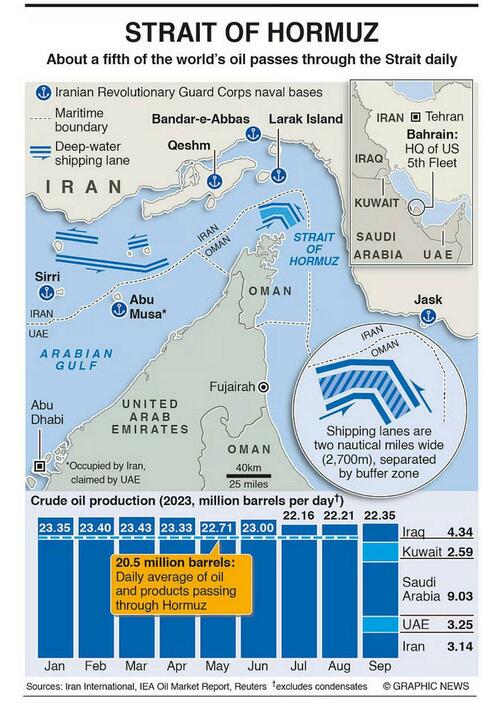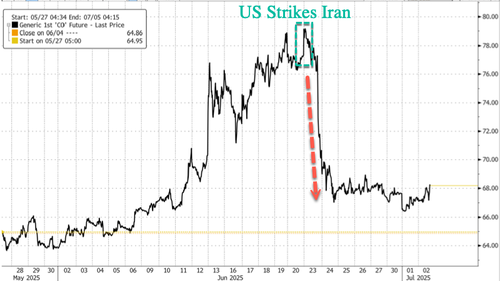The U.S. launched “Operation Midnight Hammer” on June 22, deploying stealth bombers to strike Iran’s nuclear facilities at Fordow, Natanz, and Isfahan using Massive Ordnance Penetrator bombs. President Trump declared the sites were “totally obliterated.” In retaliation, Iran’s parliament voted to authorize the closure of the Strait of Hormuz—a critical maritime chokepoint through which 20% of the world’s oil flows—sparking renewed anxiety among global energy traders over the threat to vital tanker lanes.
As readers understand, any move by Iran to close the critical waterway would instantly disrupt nearly one-fifth of the world’s oil shipments and trigger substantial—and potentially cascading—economic harm (energy inflation) worldwide. However, those threats ultimately fell short in the days that followed, and Brent crude futures have since returned to the $67-a-barrel level, effectively roundtripping the entire move.
Iran has several military and asymmetric tools at its disposal to disrupt or close the Strait of Hormuz, including:
-
Naval Mines
-
Fast Attack Boats & Swarm Tactics
-
Anti-Ship Missiles
-
Submarine Operations
-
Seizing or Boarding Tankers
-
Shore-Based Artillery or Rocket Attacks or Drone Strikes
-
GPS Scrambling
-
Cyberattacks on Port Infrastructure
-
Coordinated Proxy Attacks
In the lead-up to and during Operation Midnight Hammer, widespread GPS interference was reported across the Strait of Hormuz. Multiple sources we highlighted indicated a noticeable slowdown in tanker traffic, as navigation systems were degraded and insurance premiums for vessels surged.
A new Reuters report, citing anonymous U.S. officials, reveals that intelligence indicated Tehran was preparing to blockade the Strait of Hormuz using one of its most effective and low-cost tactics: littering the narrow shipping corridor with naval mines.
More color on the report:
The previously unreported preparations, which were detected by U.S. intelligence, occurred some time after Israel launched its initial missile attack against Iran on June 13, said the officials, who requested anonymity to discuss sensitive intelligence matters.
The loading of the mines – which have not been deployed in the strait – suggests that Tehran may have been serious about closing one of the world’s busiest shipping lanes, a move that would have escalated an already-spiraling conflict and severely hobbled global commerce.
. . .
Reuters was not able to determine precisely when during the Israel-Iran air war Tehran loaded the mines, which – if deployed – would have effectively stopped ships from moving through the key thoroughfare.
It is also unclear if the mines have since been unloaded.
The sources did not disclose how the United States determined that the mines had been put on the Iranian vessels, but such intelligence is typically gathered through satellite imagery, clandestine human sources or a combination of both methods.
. . .
The two officials said the U.S. government has not ruled out the possibility that loading the mines was a ruse. The Iranians could have prepared the mines to convince Washington that Tehran was serious about closing the strait, but without intending to do so, the officials said.
Israel’s 12-day war with Iran and Tehran’s ultimately hollow threat (so far) to close the Strait of Hormuz appear to have had limited lasting impact on global oil markets, reflected in Brent crude trading around $68 on Wednesday afternoon.
Loading…



















